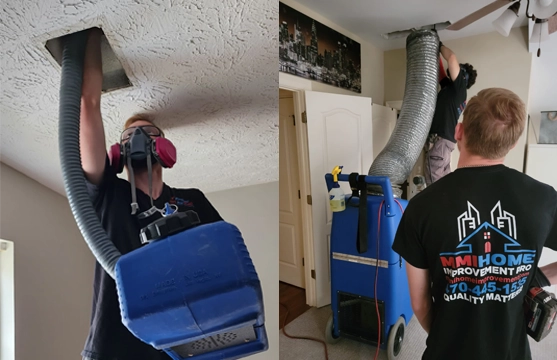So, your house needs work—but should you be the one to do it? Maybe you’re tight on time. Maybe you’re tight on cash. Or maybe you just want to sell and move on.
Selling as-is sounds tempting, but could you be leaving money on the table?
Before you grab a paintbrush or skip the whole thing, let’s break down what really makes sense for your situation.
Key Notes
- As-is sales attract fewer buyers but offer faster closings with no repair costs.
- Market conditions significantly impact which approach yields better returns.
- Consider repair costs versus potential value increase before deciding.
- Investors and cash buyers are your primary market for homes needing significant work.
Should You Sell As Is or Fix it Up?
Selling a home comes with big decisions. One of the biggest: Whether to sell as-is or make repairs first.
Both have perks and drawbacks, and the right choice depends on your financial situation, time constraints, and local market conditions.
Some homes fly off the market even when they need work. Others sit for months because buyers expect move-in-ready properties. So how do you decide?
Selling Your Home As-Is
Selling your home as-is means listing it without making any repairs or upgrades. Buyers accept its current condition and take responsibility for repairs after purchase.
This option works well for sellers who need a quick sale or don’t have the funds for renovations. It’s also common for inherited homes or properties with major repairs that aren’t worth tackling.
The trade-off? A lower sale price and a smaller pool of potential buyers. Investors and house flippers may be your best bet, but traditional buyers might hesitate. If you’re considering a cash sale, knowing what qualifies as a fair offer can help you avoid being undercut and make a more informed decision.
Pros of Selling As Is
- No Repair Costs – Skipping renovations saves you thousands. The average cost to fix up a house to sell ranges from $10,000 to $50,000, depending on the work needed.
- Faster Sale – Selling as-is speeds up the process, especially if you attract investors or cash buyers.
- Less Stress – No juggling contractors, managing timelines, or living in a construction zone.
- Avoid Holding Costs – The longer you hold onto a house, the more you pay in taxes, utilities, and mortgage interest.
Cons of Selling As Is
- Lower Sale Price – Cash buyers offer less to compensate for repair costs.
- Limited Buyer Pool – Many buyers want turnkey homes, not fixer-uppers. Your options may be limited to investors, house flippers, or bargain hunters.
- Potential Appraisal Issues – If a home needs too much work, it may not qualify for traditional financing. That takes away a chunk of buyers.
Selling As Is – Whose It Best For?
Consider selling as is if you:
- Are on a tight budget
- Have inherited property you don’t want to sink money into
- Need to relocate urgently without time for repairs
- Are faced with structural damage or major repairs exceeding 20% of your home’s value
Making Repairs Before Selling
Fixing your home before selling can increase its value and attract more buyers.
Some repairs, like a fresh coat of paint or new flooring, offer a solid return on investment. Others, like major structural fixes, might not be worth the effort.
If your home is in decent condition but could use minor updates, this approach can help maximize your sale price. On the flip side, repairs take time and money, and there’s no guarantee you’ll recoup the costs.
Weigh the potential gains against the upfront investment to see if it makes sense.
Pros of Repairing Before Selling
- Higher Sale Price – A move-in-ready home attracts more buyers and stronger offers.
- Faster Traditional Sale – Turnkey properties tend to sell faster than fixer-uppers.
- More Buyers Interested – A well-maintained home broadens your pool of potential buyers.
- Better Appraisal & Financing – Homes in good condition are more likely to pass inspections and qualify for mortgages, reducing financing hiccups.
Cons of Repairing Before Selling
- Upfront Costs – Repairs cost money, and the return isn’t always guaranteed.
- Time-Consuming – Depending on the work, it could take weeks or months to complete repairs before listing.
- Unexpected Issues – Once you start fixing things, more problems may surface.
Repairs Before Selling – Whose It Best For?
Consider repairs before selling if you:
- Are selling in a competitive market
- Have a home that only needs minor cosmetic updates to boost its appeal
- Are not in a rush and want the best return
How To Decide?
- Assess the Market – In a seller’s market, you might get away with selling as-is because demand is high. In a buyer’s market, making repairs could be necessary to compete.
- Get Repair Estimates – Get quotes and compare the cost of repairs to the potential increase in sale price.
- Weigh the ROI – Some upgrades have a higher return. Others, like major structural fixes, might not.
- Consult a Real Estate Agent – They know what buyers expect.
- Sell to an Investor – For a fast cash sales without repairs.
Frequently Asked Questions
Should I sell my house as is or fix it up?
Selling as is or fixing up depends on your financial situation and goals. If you need a quick sale selling as-is makes sense. If you want top dollar and have the time and money to invest, making upgrades could pay off.
What is the average cost to fix up a house to sell?
The average cost to fix a house to sell varies. Minor cosmetic fixes can run $5,000–$10,000, while major renovations can reach $50,000 or more.
How do I sell a house that needs repairs?
If you want to sell a house that needs repairs, list it as-is, price it competitively, and market it to investors or cash buyers. Disclose all known issues to avoid legal trouble.
Conclusion
Selling your home—whether as-is or after repairs—isn’t just about money. It’s about time, energy, and how much hassle you’re willing to take on.
If you’re short on time or funds, selling as-is can make life simpler. If you’ve got the means and want a better return, strategic updates can widen your buyer pool and raise your price.
But here’s what most people miss: your local market does a lot of the deciding for you. What works in one zip code might flop in another. So before picking up a hammer—or handing off the keys—look around, not just within.


































